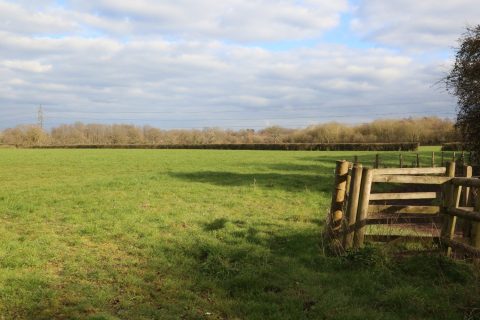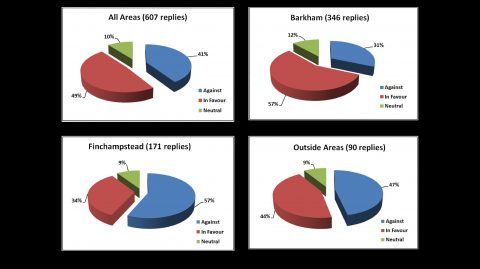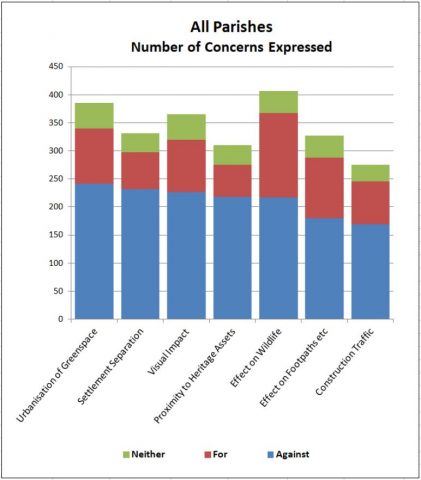Barkham Parish Council
Response to Public Consultation
Proposed Solar Farm, South Barkham

BACKGROUND
During the early stages of the consultation period it was evident that residents had strong views which fell into two distinct groups:
GROUP A) There were mixed feelings that spanned the spectrum from those very much in favour of the move to green energy and those appalled by the negative impact it would have on the countryside, pathways, heritage assets and wildlife. BPC felt it was necessary to conduct a survey to sample a broader cross section of the population.
GROUP B) There was also dismay and frustration – where was all this going? With 1800 new homes built or planned for Barkham with another 1700 just over the parish boundaries, 140 homes on the Reading Football Club Training Ground – what will the rest of the WBC owned land be used for?
More recently these fears have been compounded by the revelation that 200 homes are planned for Rooks Nest Farm and the possibility of a crematorium mooted (Reference: EIA Scoping Package, Appendix F, Pages 97 and 98, dated April 2020). People questioned the relevance of the 4000 names petition completed in 2018 re further development of the area and the Neighbourhood Plan made in 2020. BPC was unable to comment – it does not know – it is asking the same questions.
THE SURVEY
The survey was launched by leafleting every household in Barkham – some 1600 addresses, issuing a Barkham Village Development Watch alert and posting on a number of social media sites such as the Finchampstead and Barkham Community page.
To allow for the extreme pandemic conditions prevailing at the time, a wide range of measures were put in place to collect responses.
Electronic responses were encouraged by providing a QR code link to the online survey as well as supplying a dedicated e-mail address. For those more at ease with completing a paper version, provision was made for these to be returned via the parish clerk or at dedicated drop-off points established at The Bull public house take-away collection point and Barkham Post Office.
The survey asked three simple questions:
Question 1: Are you ‘For’, ‘Against’ or ‘Neither for nor against’ the solar farm proposal.
Question 2: Residents were asked to indicate if they were ‘Concerned’, ‘Unconcerned’ or ‘Neutral’ about seven topics raised during the early discussions such as visual impact, loss of landscape and proximity to the church.
Question 3: ‘Any other comments,’ followed by a free text field into which residents could add their own comments.
RESPONSE TO THE SURVEY
1. 607 responses were received including 346 from Barkham representing a good distribution across the parish and local area (see Chart 1).
2. Overall, 49% supported the proposed solar farm. In Barkham, 57% were in favour of the solar farm in contrast to 34% and 44% respectively for Finchampstead and the other parishes (see Chart 2).
Based on the informal discussions and the response to Question 3 (see New Themes below), it is believed the different view expressed by Barkham, which is particularly sensitive to the current level of development and the constant threat of further development, could be attributed to a preference for the solar farm over housing.
3. All seven topics listed in Question 2. were strongly supported. When charting the total number of concerns against how people voted, it can be seen that many in favour of the project and those who were neither for nor against also had many concerns. All the concerns need to be mitigated (see Chart 3).
NEW THEMES
People responding to the survey were invited to complete the catch-all Question 3 and provide additional comments. The full list of comments and concerns from Barkham residents is included as Attachment 1.
381 respondents from all parishes took advantage of this. Many of these comments reflected how respondents had voted in the first two questions and these will not be discussed further here except to note the strength of feeling – both ways. However, four new themes emerged:
• Why use greenfield sites for this purpose? Why not focus on brownfield locations? Why not mount solar arrays on roofs of WBC owned commercial property and on all new build housing? Why not locate along the motorways where the landscape has already been impacted? Raised 47 times.
• The process was challenged. Will the land ever be restored to farming? Greenfield to brownfield then to housing? How will the residents benefit? Has noise and drainage been considered? Is it cost effective? South of Barkham Ride OK but not to the north and proximity to the Church? Alternative approaches to climate change? Flood risks and drainage onto roads? Excessive scale? Infrastructure – status of roads? What is the value of Local and Neighbourhood Plans? Raised 52 times.
• Many stated a clear preference for the solar farm over housing. Raised 45 times.
• Concern about the loss of farms when there is increasing emphasis on self-sufficiency and the impact on the livelihood of the tenant farmers. Raised 34 times.
SPECIAL REQUEST
A representative of St James Church, Barkham has requested that as the churchyard is nearing capacity, an area, say half an acre, is set aside in the adjacent field to allow for expansion of the burial ground. BPC supporting comment – the extension of the graveyard by at least 0.5 acres, not including screening, should help to allay concerns of the solar farm encroaching on the church in a natural way.
LOCAL ARCHAEOLOGICAL INPUT
Janet Firth (BA Hons) is a trained Archaeologist and, until recently Chair of the Berkshire Archaeology Research Group. Under the auspices of this group, she has organised field walks over the fields that will, if approved, become the solar farm – details of all the resulting finds have been submitted to the Berkshire Heritage Environment Record (HER). She is co-author of the popular book – Barkham: A History. BPC felt her excellent response should be submitted in full and it will be included with the response.
CONCLUSION
The basic message is that the move to green energy and the fear of yet more housing is driving Barkham residents to support the project, although very reluctantly. There is less support from Finchampstead and the other parishes.
No matter whether for or against, many concerns were raised which need to be addressed with mitigations put in place. Several of these mitigations, such as landscape buffers and screening to heritage sites, are alluded to in the EIA scoping document published under Planning Application No. 210046 and should be carefully considered.
Feedback explaining how the concerns expressed will be addressed should be provided to the parishes BEFORE the Planning Application is brought forward.
BPC would welcome, indeed requests, the opportunity to work with the Project Team to address both GROUP A (as in Background) subjects to agree substantive mitigations and GROUP B (as in Background) subjects to be party to the process whereby the future of Barkham, its parish, will be decided.
CHART 1

CHART 2

CHART 3


